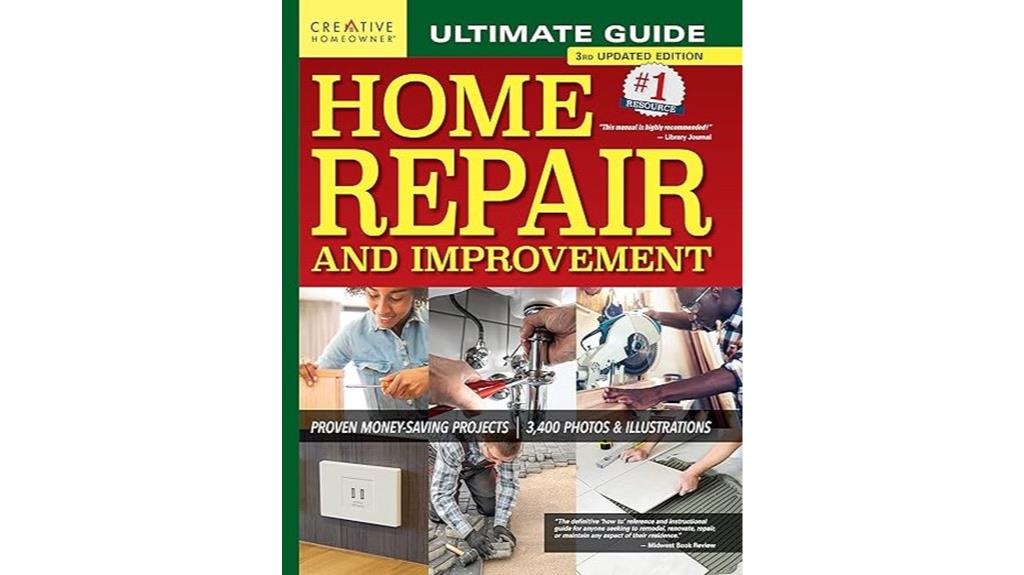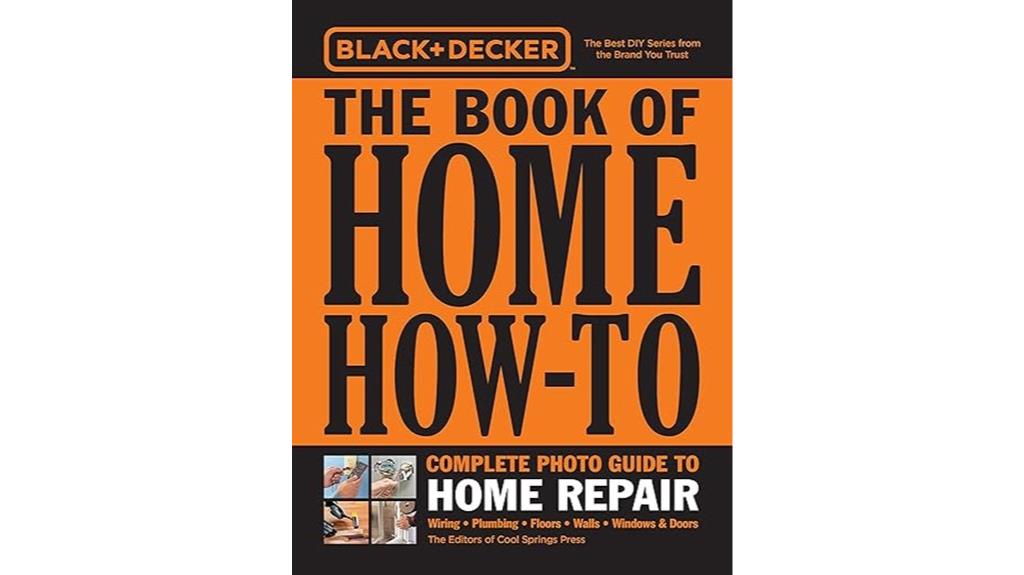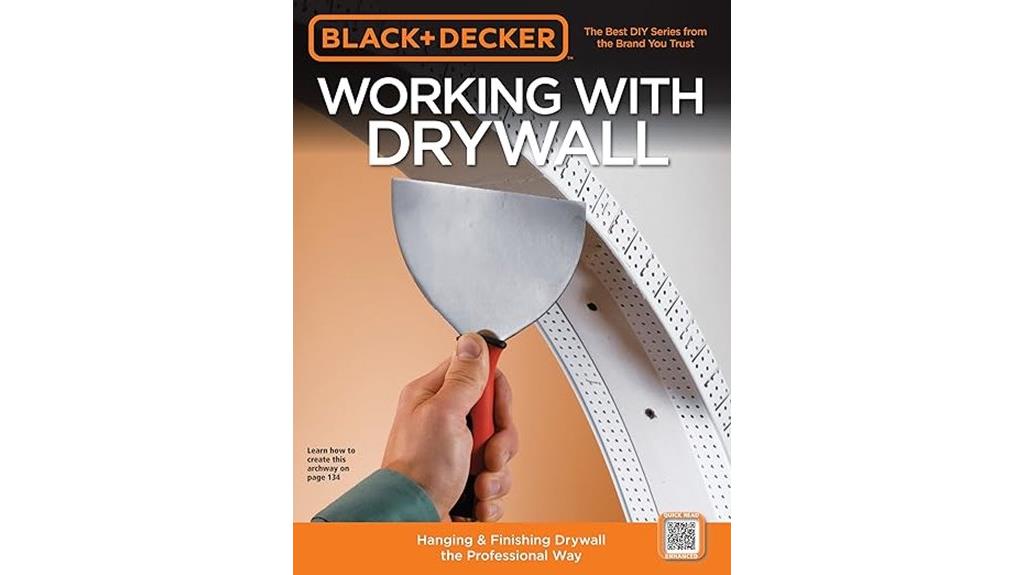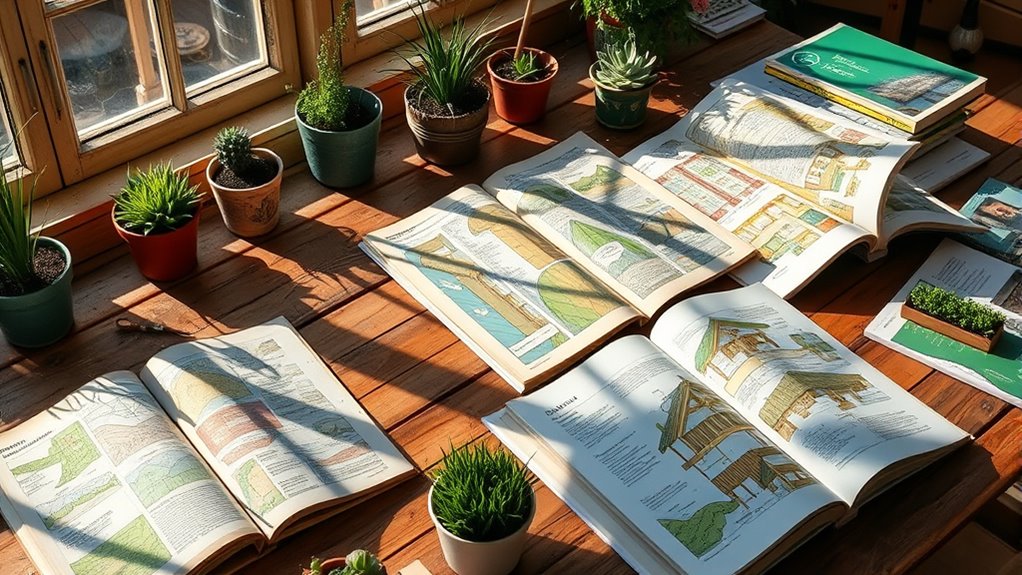If you’re looking to build eco-friendly roofs, I recommend checking out a mix of detailed guides and practical resources. Books like *Ultimate Guide to Home Repair and Improvement* and *Black & Decker Roofing, Siding & Trim Guide* offer step-by-step advice, visuals, and tips suited for DIYers. For more specialized knowledge, *The Slate Roof Bible* provides in-depth insights. If you’re enthusiastic to incorporate green techniques, exploring these titles will give you the confidence and expertise you need to succeed.
Key Takeaways
- Many DIY guides cover eco-friendly roofing options, including green roofs, solar integration, and sustainable materials.
- Books like *”Complete Guide to Roofing and Solar”* offer practical advice on energy-efficient roofing and eco-friendly upgrades.
- Specialized titles such as *”The Slate Roof Bible”* provide technical insights for durable, eco-conscious roofing materials.
- Resources often include step-by-step instructions, safety tips, and design ideas for building sustainable roofs yourself.
- Reputable books feature illustrations, checklists, and expert guidance to help beginners and experienced DIYers create eco-friendly roofs.
Ultimate Guide to Home Repair and Improvement (Creative Homeowner)

If you’re a homeowner looking to tackle repairs and upgrades with confidence, the “Ultimate Guide to Home Repair and Improvement (Creative Homeowner)” is an excellent resource. It offers 3,400 photos and illustrations, making complex projects easier to understand. The step-by-step instructions help beginners and experienced DIYers alike, covering tasks from faucet replacements to siding repairs. I appreciate how visual aids boost my confidence and help me avoid costly mistakes. While some sections may require supplementary videos, overall, this guide empowers me to handle repairs efficiently, save money, and develop practical skills for eco-friendly upgrades like green roofing.
Best For: homeowners and DIY enthusiasts seeking a comprehensive, visually guided resource to confidently undertake home repairs and improvements.
Pros:
- Includes 3,400 detailed photos and illustrations for clear visual guidance
- Step-by-step instructions that simplify complex projects for beginners and experienced DIYers
- Provides practical, money-saving tips and helps prevent costly mistakes
Cons:
- Some sections may require supplementary resources like videos for more in-depth guidance
- Certain topics assume basic prior knowledge, which might challenge complete novices
- Not a substitute for specialized tutorials on highly complex or technical repairs
Complete Book of Framing: An Illustrated Guide for Residential Construction

The Complete Book of Framing stands out as an ideal choice for DIY enthusiasts and beginners keen to learn residential framing with confidence. I find it highly useful because of its clear explanations, detailed illustrations, and practical diagrams that make complex concepts simple to understand. It’s an all-in-one guide that covers essential framing techniques, helping you build sturdy, professional-looking structures. While it doesn’t explore into every advanced detail, its structured approach makes learning accessible and enjoyable. I’ve found it to be a valuable resource for both starting projects and refining my skills, making it a must-have for any DIY builder interested in eco-friendly construction.
Best For: DIY enthusiasts and beginners eager to learn residential framing confidently through clear guidance and illustrated instructions.
Pros:
- Highly detailed illustrations and diagrams that simplify complex framing concepts
- Comprehensive and well-organized, making it suitable for both beginners and experienced builders
- Practical explanations and definitions that enhance understanding and build skills effectively
Cons:
- Does not cover all advanced or specialized construction techniques, such as attaching floor joists to block foundations
- Some users may find the introductory sections more engaging than the detailed content itself
- Lacks in-depth coverage of certain technical or heavy-duty framing procedures needed for complex projects
Green Clean Natural Cleaning Solutions for Home

For homeowners enthusiastic to make their cleaning routines safer and more eco-friendly, the “Green Roofing DIY Books” offers practical guidance on natural cleaning solutions. I’ve found that simple ingredients like vinegar, baking soda, and essential oils can tackle dirt, grime, and soap scum effectively without harsh chemicals. Using recipes such as vinegar and club soda for glass or baking soda paste for stains makes cleaning easier and healthier for my family. These methods reduce plastic waste, improve indoor air quality, and are budget-friendly. Overall, switching to green cleaning has transformed my routine into a safer, more sustainable practice that’s just as effective—if not more so.
Best For: homeowners seeking safe, eco-friendly, and cost-effective cleaning solutions to maintain a healthy and sustainable household environment.
Pros:
- Uses natural ingredients like vinegar, baking soda, and essential oils, eliminating exposure to toxic chemicals
- Reduces plastic waste by reusing bottles and making homemade cleaning solutions
- Cost-effective and simple recipes that are easy to implement for all household areas
Cons:
- Some natural ingredients may have strong odors that require acclimation or additional ventilation
- Effectiveness can vary with stubborn stains or heavily soiled surfaces requiring multiple applications
- May require some experimentation to find the most suitable natural cleaning techniques for specific surfaces
Shipping Container Homes Guide for Beginners

Are you curious about turning recycled shipping containers into affordable, eco-friendly homes? I found a thorough guide perfect for beginners that walks you through every step. It covers planning, budgeting, and site selection, making sure you understand zoning laws and safety standards. The book provides design ideas from minimalist to multi-container setups, with practical advice on materials and construction timelines. It also emphasizes legal considerations, ensuring your project complies with local regulations. Whether you want a cozy retreat or address housing needs, this guide inspires confidence and offers clear instructions, helping you turn a recycled container into a stylish, sustainable home.
Best For: beginners interested in building affordable, eco-friendly, and stylish shipping container homes with minimal prior construction experience.
Pros:
- Comprehensive step-by-step guidance suitable for novices
- Emphasizes legal, safety, and design considerations ensuring compliance
- Offers inspiring design ideas and practical tips for DIY projects
Cons:
- May require additional research for specific local regulations and permits
- Construction timelines could vary depending on individual skills and site conditions
- Limited coverage on advanced customization or large-scale multi-container configurations
Black & Decker Roofing, Siding & Trim Guide

If you’re a beginner or DIY enthusiast looking for straightforward guidance on roofing, siding, and trim projects, the Black & Decker Roofing, Siding & Trim Guide is an excellent choice. It offers clear, step-by-step instructions with helpful pictures, making it easy to tackle basic tasks like removing old roofing or installing shingles. The book focuses mainly on 3-tab shingle roofs and is perfect for reroofing a garage or small project. While it’s great for beginners and intermediate DIYers, professionals might find it somewhat limited for complex or advanced projects. Overall, it’s a practical, affordable resource that boosts confidence for small to medium exterior home improvements.
Best For: DIY beginners and intermediate homeowners seeking straightforward, step-by-step guidance on roofing, siding, and trim projects, primarily focusing on simple shingle roofing tasks.
Pros:
- Clear instructions with helpful pictures make projects easier to understand
- Affordable price and good value for introductory home improvement guides
- Suitable for small to medium DIY projects like reroofing garages or siding upgrades
Cons:
- Limited coverage of complex or advanced roofing systems and materials
- Lacks in-depth technical details needed by professional tradesmen
- Vague in some areas, requiring additional resources for specialized or large-scale projects
DIY Solar Projects Book

The “DIY Solar Projects” book stands out as an ideal choice for beginners or homeowners seeking practical, easy-to-follow solar projects. It features clear instructions, vibrant photos, and projects that can often be completed in a weekend. I appreciate how it simplifies complex concepts, making solar power accessible without needing advanced technical skills. Whether you want small science experiments or full-home systems, this book covers a wide range of ideas. It explains components and assembly steps in straightforward language, boosting confidence for DIY enthusiasts. Overall, it’s an excellent resource to start harnessing solar energy and building eco-friendly, cost-effective solutions.
Best For: beginners, homeowners, and DIY enthusiasts looking for practical, easy-to-understand solar projects to build and learn from.
Pros:
- Clear, well-written instructions with vibrant color photographs
- Projects that can often be completed within a weekend, ideal for beginners
- Covers a wide range of ideas from small experiments to full-home systems
Cons:
- Limited technical details on advanced wiring and system design
- May require supplementary resources for in-depth electrical troubleshooting
- Some users wish for more detailed technical explanations on component integration
Black & Decker Home Repair Guide: Wiring, Plumbing, Floors, Walls, Windows & Doors

For homeowners new to house maintenance, the Black & Decker Home Repair Guide offers a straightforward and accessible resource covering wiring, plumbing, floors, walls, windows, and doors. It’s perfect for those with no prior experience, providing step-by-step instructions, tips, and helpful visuals to simplify repairs. The guide is user-friendly, making complex tasks manageable and boosting your confidence. It also includes practical advice to maintain your home and save money by handling routine repairs yourself. Plus, it’s an affordable option available on Amazon, making it a valuable gift for family members or anyone looking to build DIY skills for household upkeep.
Best For: Homeowners with no prior experience seeking a comprehensive, easy-to-follow guide for basic household repairs.
Pros:
- User-friendly with step-by-step instructions and helpful visuals.
- Covers a wide range of topics including wiring, plumbing, floors, walls, windows, and doors.
- Affordable and readily available on Amazon, making it an accessible resource for DIY repairs.
Cons:
- May lack the detailed technical depth needed for complex or advanced repairs.
- Designed primarily for beginners, so experienced handymen might find it too basic.
- Limited to fundamental repairs, not suitable for extensive home renovation projects.
Complete Guide to Roofing and Solar for Homeowners

Are you a homeowner keen to understand roofing and solar options without relying solely on contractors? This guide helps you grasp the basics of roof repair, replacement, and energy-efficient materials, so you can ask better questions and avoid costly mistakes. It explains how solar power is growing, with incentives and cost savings up to $40,000 per decade. You’ll learn if DIY solar installation is feasible, evaluate contractor proposals, and understand your home’s energy needs. With checklists and practical tips, this book empowers you to make informed decisions, manage projects effectively, and build an eco-friendly, cost-efficient roof.
Best For: homeowners seeking a comprehensive, easy-to-understand resource to independently navigate roofing and solar energy decisions without relying solely on contractors.
Pros:
- Provides clear, practical guidance and checklists for DIY projects and contractor evaluation.
- Explains energy savings and incentives, helping homeowners maximize financial benefits.
- Empowers homeowners with foundational knowledge to ask informed questions and avoid costly mistakes.
Cons:
- Some content may be overly promotional, focusing on the author’s roofing business.
- The book may be too basic for advanced homeowners or professionals seeking in-depth technical details.
- Certain topics may lack detailed step-by-step instructions for complex DIY installations.
The Slate Roof Bible

If you’re looking for a thorough guide that combines detailed history, technical insights, and practical advice on slate roofing, “The Slate Roof Bible” is your top choice. This detailed book covers everything from slate roofing’s rich history to advanced installation techniques, making it ideal for both beginners and seasoned tradespeople. Filled with clear diagrams, photos, and real-world stories, it emphasizes proper tools and methods to guarantee durable, quality results. Whether you’re repairing, installing, or simply learning about slate roofs, this book offers invaluable guidance. Many readers find it to be an indispensable resource for building or maintaining beautiful, eco-friendly slate roofs.
Best For: professionals, DIY enthusiasts, homeowners, and building owners seeking comprehensive guidance on slate roofing installation, repair, and maintenance.
Pros:
- Offers detailed technical insights combined with practical advice suitable for all skill levels.
- Contains high-quality diagrams, photos, and real-world stories that enhance understanding and engagement.
- Serves as an authoritative, well-rounded resource on slate roofing history, craftsmanship, and best practices.
Cons:
- May be too detailed or technical for complete beginners with no prior roofing experience.
- The comprehensive nature might be overwhelming for those seeking quick or simple solutions.
- The cost of the book and recommended supplies may be higher than more basic roofing guides.
Black & Decker Drywall Hanging & Finishing Guide

The Black & Decker Drywall Hanging & Finishing Guide stands out as an essential resource for DIY homeowners enthusiastic to tackle drywall projects with confidence. It offers detailed, step-by-step instructions for hanging, finishing, texturing, and repairing drywall, complemented by clear illustrations and visual aids. The book emphasizes proper techniques like ensuring studs are straight and flat, and covers tools, materials, and finishing methods. Many users have found it invaluable for achieving professional results and saving money. It also includes guidance on related tasks like painting preparation and soundproofing, making it a versatile guide for homeowners undertaking significant drywall work.
Best For: DIY homeowners and enthusiasts seeking comprehensive, easy-to-follow guidance on drywall installation, finishing, and repairs to achieve professional results.
Pros:
- Clear step-by-step instructions complemented by high-quality illustrations and visual aids.
- Covers a wide range of drywall projects, including texturing and repairs, with practical tips for success.
- User-friendly across multiple devices, making it accessible for digital learners.
Cons:
- Some topics like suspended ceilings and advanced framing are not covered in detail.
- QR codes for additional videos or digital resources are often outdated or missing.
- Limited coverage of complex design techniques and a smaller selection of expert tips.
How to be Handy DIY Skills Guide

How to be Handy stands out as the perfect guide for beginners or anyone looking to build confidence in basic DIY skills. It’s a practical, engaging book filled with common sense, humor, and real-world advice. I appreciate how it emphasizes safety and encourages curiosity, making DIY approachable for everyone. Whether you’re changing a plug, fixing a leak, or tackling simple repairs, this book helps you develop essential skills without jargon or intimidation. It’s like learning from a wise friend who’s been there. With its friendly tone and clear instructions, I’ve gained confidence and independence—proof that anyone can become more handy with patience and effort.
Best For: beginners, DIY enthusiasts, and anyone seeking practical, straightforward guidance to develop home repair skills confidently.
Pros:
- Clear, friendly instructions that make complex tasks accessible
- Emphasis on safety and building confidence without jargon
- Humorous and engaging style that encourages learning and curiosity
Cons:
- Occasional grammatical errors and odd sentence structures noted by some readers
- Limited to general DIY topics, excluding specialized fields like bricklaying
- Minor printing defects, such as vertical blank lines, in some editions
Factors to Consider When Choosing Green Roofing DIY Books

When selecting green roofing DIY books, I consider how well the content matches my skill level and project needs. I also look for clear visuals, step-by-step instructions, and eco-friendly tips that make the process easier and more sustainable. Finally, I evaluate the range of projects covered to ensure I find a book that offers useful guidance for my specific goals.
Relevance of Content Depth
Have you ever wondered if a green roofing DIY book offers enough technical detail to guide you confidently through your project? Content depth is vital because it guarantees you understand core principles like environmental benefits, materials, and installation techniques. A good book should strike a balance between fundamental concepts and practical, step-by-step instructions tailored for DIYers. It’s important the resource covers eco-friendly materials, insulation options, and energy efficiency considerations, so you’re fully informed. Additionally, thorough coverage of maintenance, troubleshooting, and long-term sustainability helps match the book to your experience level. Assess if the technical details are thorough enough for your needs or if you might need supplementary resources for advanced topics. The right depth empowers you to build an eco-friendly roof safely and confidently.
Visual and Illustration Quality
Since green roofing involves multiple layers and precise installation steps, high-quality visuals and illustrations are crucial for understanding the process. Clear diagrams, photographs, and step-by-step visuals help me interpret instructions accurately and execute projects safely. Well-designed illustrations can demonstrate details like layering, attachment methods, and material application that might be hard to grasp through text alone. These visual aids should complement written guidance, especially for beginners with no prior experience. Detailed, accurate visuals not only clarify complex concepts but also boost my confidence and overall learning. When choosing a green roofing DIY book, I look for those that prioritize visual quality, ensuring I can follow along easily and achieve professional results. Good visuals are essential for successful, safe projects.
Practical Step-by-Step Guidance
Choosing the right green roofing DIY book means paying close attention to how it guides you through each step of the project. I look for books that offer clear, detailed, and sequential instructions, making complex tasks manageable. Visual aids like diagrams, photos, or illustrations are essential—they help me understand proper techniques and materials. I also guarantee the guide includes safety tips and troubleshooting advice to prevent common mistakes, especially if I hit snags along the way. It’s important that instructions suit different skill levels, from beginners to more experienced DIYers, so I can follow along confidently. Lastly, practical tips on selecting eco-friendly materials and tools help assure my project is both successful and sustainable. This all-encompassing guidance makes all the difference in achieving a durable, eco-friendly roof.
Environmental Focus and Tips
What should you look for in a green roofing DIY book to verify it aligns with your environmental values? First, check if it emphasizes eco-friendly materials and sustainable practices, like recycled or low-impact components. Prioritize books that offer practical tips on reducing energy use and incorporating renewable energy solutions, such as solar panels. Look for guides that detail environmentally safe maintenance techniques, including natural cleaning methods and minimal chemical use. It’s also helpful if the book highlights the environmental benefits of green roofs, like better insulation, stormwater management, and reducing the urban heat island effect. Ultimately, ensure it provides actionable advice on sourcing locally available, eco-conscious materials, so you can minimize your project’s carbon footprint during installation and ongoing maintenance.
Project Scope and Variety
When selecting a green roofing DIY book, it’s important to take into account the range of projects it covers to ensure it matches your goals and skill level. I look for resources that include a variety of projects, from small repairs to full eco-friendly roof replacements. It’s helpful if the book offers diverse techniques, like installing green roofs, living roofs, or adding solar elements. Clear, step-by-step instructions for different materials and sustainable options are essential, so I can follow along confidently. I also check if the guide discusses planning, budgeting, and project scale, ensuring it suits my specific scope. Visual aids and illustrations are valuable for understanding different stages and design ideas, especially for projects of varying sizes.
Author Expertise and Credibility
Have you ever wondered how to tell if a green roofing DIY book is truly trustworthy? The key is to check the author’s expertise and credentials. A reputable author should be recognized as an expert in sustainable architecture, roofing, or environmental building practices. Their background in green building techniques and practical experience adds credibility to their advice. Look for authors who have published extensively or hold professional affiliations with respected environmental or construction organizations. Credible writers often reference current standards, codes, and research, showing their guidance is grounded in the latest industry practices. An author with real-world project experience or teaching credentials can also provide valuable insights that go beyond theory, making their advice more practical and reliable for your DIY green roofing project.
Frequently Asked Questions
What Are the Initial Costs Associated With Green Roofing Projects?
When considering green roofing projects, I find the initial costs can vary quite a bit. Generally, you should budget for materials like waterproof membranes, drainage layers, soil, and plants, plus installation. While it might seem pricey upfront—ranging from $10 to $30 per square foot—it’s an investment in energy savings and environmental benefits. I recommend researching specific materials and local costs to get a clearer picture for your project.
How Long Does a Typical Green Roof Installation Take?
A typical green roof installation usually takes about 3 to 5 days, depending on the project’s size and complexity. I’ve found that careful planning and prep work can streamline the process. If you’re doing it yourself, expect more time for research and setup. Rushing can cause issues later, so I recommend patience and thoroughness to make certain your green roof is installed properly and lasts for years to come.
Are There Specific Climate Considerations for Green Roofing Success?
Climate really impacts green roofing success, and I always consider local weather conditions first. For example, in hot, sunny areas, I choose drought-resistant plants and guarantee proper irrigation. In colder climates, I focus on hardy, frost-tolerant species and insulation. Understanding rain patterns helps me design adequate drainage. By tailoring my approach to the climate, I make certain my green roof thrives year-round, saving me time and effort.
What Maintenance Is Required for Eco-Friendly Roofs Over Time?
Maintenance for eco-friendly roofs involves regular inspections, timely weeding, and proper watering, ensuring plants stay healthy and thriving. I check for debris buildup, monitor drainage, and address pest issues promptly. Periodic fertilizing keeps plants vibrant, while pruning maintains their shape. Consistent upkeep preserves the roof’s eco benefits, prevents damage, and prolongs its lifespan, so I make maintenance a priority to enjoy a sustainable, green roof that benefits both my home and the environment.
Can DIY Green Roofing Be Integrated With Existing Roofing Structures?
Absolutely, you can integrate DIY green roofing with existing structures, but it’s essential to evaluate the current roof’s condition first. I recommend consulting a professional to ensure your roof can support the added weight and moisture. Then, I suggest starting with lightweight, modular green roof systems. With proper planning and careful installation, you can successfully create an eco-friendly roof that enhances your home’s sustainability and beauty.
Conclusion
Think of these books as your toolbox, each one holding a key to unleashing your eco-friendly dreams. As you turn the pages, you’ll build not just a roof, but a sanctuary rooted in sustainability and creativity. Remember, every small step you take is like planting a seed—soon, your green roof will flourish, transforming your home into a living, breathing symbol of care for our planet. Let’s get started—your eco-journey awaits!










